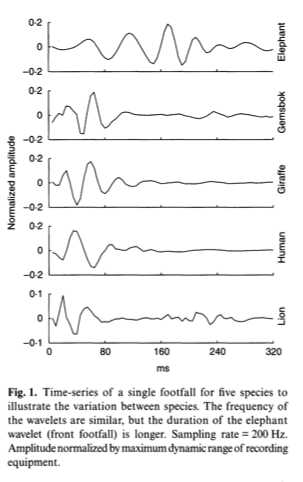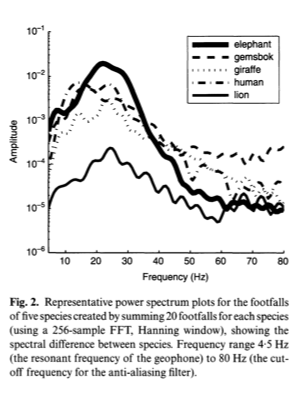Elephants
& Siesmic Communication
Stuart Steidle & Sara Post ~ Reed Bio 342
| Home | Phylogeny | Ontogeny | Mechanism | AdaptiveValue | References | CourseHome |
How exactly do they do it?
Where it starts:
The most obvious communication behavior of elephants is acoustic calling with the trunk, some of which penetrate and travel through the ground. Out of the myriad vocalizations of elephants - trumpets, snorts, barks, roars, cries, chirps, and rumblings - it is rumblings that are lowest in frequency and therefore able to travel seismically (Acoustic Communication, 2011).
Additionally, elephants can communicate through stamping their feet or their trunk, sending vibrations through the ground (O’Connell-Rodwell, Hart and Arnason, 2001). Strong ground-borne vibrations result from "mock charges," which are characterized by forceful stomping of the feet. These weighty seismic signals have been modelled to have ranges of up to 32 km (O’Connell-Rodwell, Hart and Arnason, 2001)!
Due to differences in size, shape, and gait, 4-legged animals all have distinct effects on the ground, giving each animal a signature "footprint" of seismic activity. It is thought that animals on the savannah, such as lions, could eavesdrop and assess whether vibrations are from preferred prey such as antelope, zebra, or buffalo, or from elephants, which in many cases are too large to hunt (O’Connell-Rodwell, Hart and Arnason, 2001).

Figures from Wood, O’Connell-Rodwell and Klemper (2005)
The rumblings travel through the air and ground simultaneously; some models predict the range for substrate vibrations to be up to 16 km (O’Connell-Rodwell, Hart and Arnason, 2001. Such broad expansion of elephant calls are dependent upon the environment. In 2003 Caitlin O'Connell-Rodwell and colleagues conducted stringent seismic experiments on a captive elephant in Salinas, California, and discovered that ground-borne vocalizations in regions of heavy farming and abundant background seismic noise only travel betwenn 3 and 4 km ("Scientists Unravel the secret World of Elephant Communication", 2005).
- Prime communication ("Sweet Zone") exists between 10 and 40 Hz, whereby the calls propogate to their fullest
- Both Asian and African elephants are shown to transmit high amplitude rumblings at 20 Hz, creating both acoustic and seismic waves
- Call detection and response is mainly centered around this low (20 Hz) frequency
The receiving end:
From field observation, the most evident mechanism to explain the elephants' ability to receive a seismic signal is the elephants' feet. Though we cannot say whether or not the structures inherent in elephant feet are the key tool in deciphering the seismic environment, discoveries by Caitlin O'Connell-Rodwell in 2007 show that the feet are at least part of the system. Experiments have identified Pacinian corpuscles (PCs), specialized mechanoreceptors, in the feet of Asian elephants.
- 80% of PCs occur in a clustered formation.
- Highest PC density occurs in the anterior region of the forefoot (52.19%) and the posterior region of the hindfoot (47.09%).
- In Asian elephants the density of PCs increases in the dermis, close to the sole (similar to distribution in digits of humans, monkeys, and raccoons).
- Such a lay-out takes advantage of available surface area and is well suited to detection of horizontal motion of surface waves (from vocalizations).
This research is backed up by field observation, in which elephants:
"shift weight to forefeet, lifting 1 foot to touch the most anterior portion of the foot to the ground, or rocking back onto the heels of the hindfeet [4]"
Photo by Caitlin O'Connell-Rodwell
Additionally, fatty tissue in the feet does not change volume seasonally even though other fat deposits around internal organs do fluctuate, decreasing especially in winter. This may be a sign that the fat deposits in the feet are necessitated especially by elephants, most likely for communicative reasons (O’Connell-Rodwell, 2007).
Figure from O'Connell (2011)
Via consideration of analogous traits in other animals, researchers have found other anatomical aspects to be of promise in understanding elephants' seismic interpretation, both of which relate to "bone conduction"(O’Connell-Rodwell, 2007):
- Bone structure in the skull
- Construction of the inner ear
Recent molecular data has placed Proboscidia (elephants) and golden moles - whose primary sense is touch, being particularly attuned to vibrations in the environment - in the same clade. Golden moles, it turns out, have the largest malleus (one of the tiniest inner ear bones in mammals) relative to body size in the animal kingdom. Elephant ears too have a relatively large malleus, along with enlargened ossicles, a bone type of which the malleus is a part. Such aural anatomy is characteristic of animals that use bone conduction to detect seismic signals (O’Connell-Rodwell, 2007).
Path route: Vibration -> feet -> up legs -> shoulders -> middle ear cavity
O'Connell-Rodwell (2007) points out that concurrent with the freezing behavior of elephants upon detection of a signal, they at times also lean their heads forward, a posture akin to golden moles in their detection of seismic signals. The inherent graviportal structure of elephants' forelimbs means their feet are directly aligned with their ears; leaning their heads forward may help to even more accentuate this balance, delivering highly accurate messages from the ground to the inner ear (O’Connell-Rodwell, 2007).
The two thematic phenomena of elephant anatomy above (basal mechanoreceptors & specialized feet along with bone conduction and ear construction) are not mutually exclusive. Indeed they are part a whole program. Difficulty however, lies in deciphering which system is predominant (if either), and just how they may be used in elephants' more nuanced interpretations of signals (O’Connell-Rodwell, 2007).


